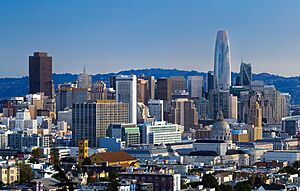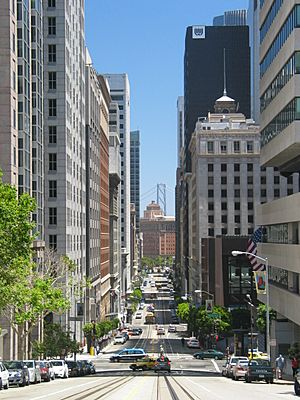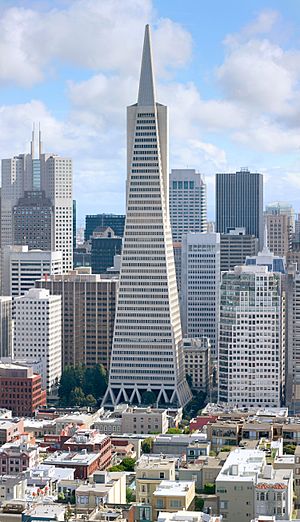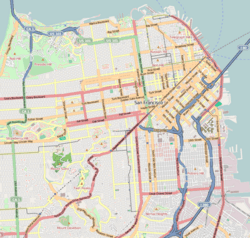Financial District, San Francisco facts for kids
Quick facts for kids
Financial District
|
|
|---|---|

San Francisco Financial District as seen from Buena Vista Park
|
|
| Nicknames:
"FiDi", "Downtown"
|
|
| Country | |
| State | |
| City-county | San Francisco |
| Area | |
| • Total | 0.460 sq mi (1.19 km2) |
| • Land | 0.460 sq mi (1.19 km2) |
| Population | |
| • Total | 9,447 |
| • Density | 20,537/sq mi (7,929/km2) |
| Time zone | UTC−8 (Pacific) |
| • Summer (DST) | UTC−7 (PDT) |
| ZIP codes |
94104, 94108, 94111, 94133
|
| Area codes | 415/628 |
The Financial District is a busy neighborhood in San Francisco, California, USA. It's like the main business hub of the city. Lots of people work here! You'll find many big company offices here. These include law firms, insurance companies, and banks.
Some very large companies have their main offices in the Financial District. These include Wells Fargo, Salesforce, and Gap.
Since the 1980s, new tall buildings have mostly been built in the South of Market (SoMa) area. This area is sometimes called the South Financial District. It's right next to the main Financial District.
Recently, many offices in the Financial District have been empty. This is because more people are working from home. This has caused some worries about the city's money.
The Financial District is easy to spot because of its tall buildings. These towers are located in a triangle-shaped area. It's east of Kearny Street and south of Washington Street. It's also west of the Embarcadero and north of Market Street.
The district has Northern California's two tallest buildings. These are the Salesforce Tower and the Transamerica Pyramid. Montgomery Street is often called the "Wall Street of the West". It's the traditional center of the district.
Contents
History of the Financial District
Early Days: Yerba Buena Cove
Long ago, under Spanish and Mexican rule, this area was a harbor. It was called Yerba Buena Cove. There was a small town nearby called Yerba Buena. This town supported soldiers at the Presidio and the Mission Dolores.
The land here was sandy and marshy. This made it hard for the Spanish and Mexican governments to build a big town. They focused on places with better land, like the Pueblo of San José.
The first settlers arrived at Yerba Buena Cove in 1835. The town's first plan was drawn in 1839. Yerba Buena was a great seaport, which made it a popular place for settlers.
Gold Rush Boom and Growth
In 1848, gold was found in the Sierra Nevada Foothills. This brought many people to Yerba Buena. People came from Europe, America, and other countries. They were looking for gold and jobs.
After California became part of the USA, the area grew very fast. The Bay shoreline used to end near Montgomery Street. But it was filled in and extended to The Embarcadero.
The wealth from the California Gold Rush made San Francisco the financial center of the West Coast. Many banks and businesses opened here. The first tall buildings on the West Coast were built along Market Street.
Rebuilding After the 1906 Earthquake
The neighborhood was almost completely destroyed in the 1906 Earthquake and Fire. However, the area's skyscrapers survived. By 1910, most of the area was rebuilt. The new buildings were usually six to twelve stories tall.
In the late 1920s, some new tall buildings were built. These were in a style called Neo-Gothic. They reached 300 to 400 feet high. Examples include the Standard Oil Building and the Russ Building.

Modern Skyscrapers and New Development
During the Great Depression, not many new buildings were constructed. Also, there were rules about how tall buildings could be because of earthquake fears. So, the district stayed relatively low-rise until the late 1950s.
New building methods and earthquake safety technology changed things. The height rules were lifted. This led to a boom in skyscraper building. This boom sped up in the 1980s. Some people called this "Manhattanization" because it looked like New York City.
This caused many people in the city to oppose it. This led to a "skyscraper revolt." Because of this, the city put very strict rules on how tall new buildings could be.
These strict height rules and a lack of empty land changed things. New development shifted to South of Market Street starting in the 1980s. This area is sometimes called the South Financial District.
To encourage building south of Market Street, many height limits were raised there. This also helped pay for a new transit center. As a result, almost all new tall buildings since the 1980s have been built South of Market.
The traditional Financial District has about 30 million square feet of office space. The South Financial District has about 28 million square feet. Together, they used to employ over 220,000 office workers.
Where is the Financial District?
The Financial District is surrounded by other interesting neighborhoods:
- To the west is the Union Square shopping area.
- To the northwest is Chinatown.
- To the north are North Beach and Jackson Square.
- To the east is the Embarcadero waterfront and the Ferry Building.
- To the south are Market Street and the South of Market district.
Getting Around
The Financial District is easy to reach by public transport. Many Muni bus and rail lines serve the area. There is even one cable car line. The Montgomery Street Station and Embarcadero Station are part of the BART system.
The nickname "FiDi" is sometimes used for the Financial District. It's similar to "SoMa" for South of Market. People also often call the area "Downtown." However, "Downtown" can sometimes mean a larger area including Union Square and Chinatown.
What Makes the Financial District Special?

This district is home to many company headquarters. Half of San Francisco's eight largest companies are here. These include Wells Fargo, Salesforce, Visa, and Gap. Other big companies like Levi Strauss and Yelp also have offices here.
The main office for the 12th district of the United States Federal Reserve is also in this area. This is an important bank that helps manage money for the country.
Shopping and Parks
There are several shopping centers in the Financial District. These include the Crocker Galleria and the Embarcadero Center. The Ferry Building Marketplace is also a popular spot.
You can find parks and plazas here too. These include Sue Biermann Park and Justin Herman Plaza. Justin Herman Plaza is where the city's New Year's celebrations happen. There's also Transamerica Redwood Park. St. Mary's Square and Portsmouth Square are nearby. They are usually considered part of Chinatown.
Diplomatic Missions
Many countries have their consulates in the Financial District. A consulate is like a small embassy. It helps citizens of that country who are visiting or living in San Francisco. It also helps with visas and other official papers.
Countries with consulates here include:
- France
- Brazil
- Guatemala
- Japan
- Luxembourg
- Mexico
- Ireland
- the Netherlands
- Singapore
- the United Kingdom
The Hong Kong Economic and Trade Office and the Taipei Economic and Cultural Office are also located in the Financial District.
See also
 In Spanish: Distrito Financiero (San Francisco) para niños
In Spanish: Distrito Financiero (San Francisco) para niños



